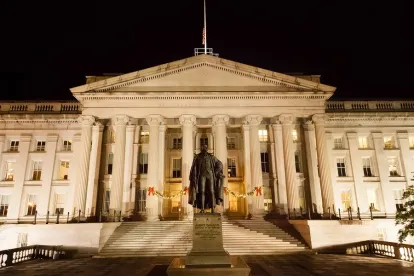As we previously have explored (see here and here), recent tax reform under the Tax Cuts and Jobs Act (TCJA) has been particularly advantageous to corporations. However, the pro-corporate policies of the current administration have extended beyond the TCJA. This is evident in the context of tax-free spin-offs, where the Treasury Department has indicated its willingness to provide rulings that would increase certainty regarding the tax-free treatment of certain spin-off transactions, as well as its support for guidance that would make it easier to qualify for such treatment. This could have significant implications, particularly in industries such as energy that steadily are moving to corporate form in light of tax and regulatory reform, as well as technology companies – often in corporate form due to their heavy venture capital investor base – that to date might struggle to meet certain spin-off requirements.
In general, a corporation (Distributing) may distribute stock of either a new or “old and cold” subsidiary (Controlled) to its shareholders in a transaction that is tax-free to both Distributing and its shareholders under Sections 355, 361 and 368 of the Internal Revenue Code, provided that a complex set of rules is satisfied. While a full discussion of spin-offs and related requirements is beyond the scope of this article, generally the distribution must have a valid business purpose and not be merely a device to allow for the distribution of earnings and profits in place of a dividend. In addition, immediately after the distribution, each of Distributing and Controlled must be engaged in the active conduct of a trade or business (known as the active trade or business or ATB requirement) that has been conducted throughout a five-year period ending on the date of the distribution (and includes trades or businesses acquired in non-recognition transactions).
The question of when a business is “active enough” to satisfy the ATB requirement long has dogged corporations seeking to engage in tax-free spin-offs, particularly in technology and other research-intensive industries, where significant costs are incurred well in advance of revenues. Historically, the focus of the ATB requirement, specifically the determination as to the commencement of the applicable five-year period, has been on the production of income – while companies operating in such industries may not be income producing until years after incurring the necessary research and development (R&D) costs. Moreover, where the industry is funded by venture capital, there may be legitimate business reasons to separate competing businesses, which may not be achievable through tax-free spin-offs due to the significant timing differences between R&D phases and income generating activities.
Presumably to address this issue, the IRS released a statement in September saying that it was reevaluating the requirement found in the regulations under Section 355(b) that a business must collect income and pay expenses in order for it to be considered as engaged in an active trade or business.1 Notably, the role of R&D in the pharmaceutical industry is cited as the motivation for revisiting the issue. As noted above, during the potentially long periods of R&D required by this industry, a business may not generate revenue even though it undertakes expensive activities the sole purpose of which is to earn income in the future. As a result, Treasury Department is looking to expand the factors that may be included in analyzing whether an active trade or business has taken place during the applicable five-year period, such as the “incurrence of significant and regular expenses… statements holding the business out as an entity that will produce income, and other businesses similarly situated that have produced income.”2 While the immediate intended beneficiaries are those in the pharmaceutical industry, we expect any clarifying guidance to apply to any business with significant R&D costs, including technology that may support developing economic systems – and attract venture capital and other investment. While the ability to engage in a tax-free spin-off may not be at the forefront of a venture capital investor’s mind, many investment strategies contemplate exit scenarios before the first dollar is invested, and require flexibility to change structures to meet the needs of the business, including the ability to efficiently separate one or more businesses. Until now, entire industries effectively were limited by the current ATB requirement from seriously considering spin-offs as a business separation method unless they could wait until the five-year mark after becoming income producing – often a considerable delay from the five-year anniversary of commencing significant, but not income generating, R&D activity. This new approach by the Treasury Department, if implemented, could be a game changer for technology companies, even if not obvious from the announcement or immediate reaction.
The Treasury Department also is hoping to continue and expand a pilot program it initiated in September 2017, which sought to provide greater assurance to taxpayers that their transactions would qualify as tax-free by granting them Private Letter Rulings (PLRs) blessing a proposed spin-off. This punctuates a long history of limiting and then potentially expanding situations in which the IRS would rule on spin-offs. Specifically, in Revenue Procedure 2013-3 the IRS announced that it no longer would rule on whether Section 355 or Section 361 (providing for non-recognition of corporate parties to reorganizations, including divisive reorganizations) applied to Distributing’s distribution of Controlled stock or securities in exchange for (and in satisfaction of) Distributing’s debt. This particularly was relevant in light of a common practice in which investors would purchase debt of Distributing on the market (or newly issued debt) with a view of exchanging such debt for stock or securities of Controlled (or other property received by Distributing from Controlled in the spin-off) in a tax-free exchange in connection with a planned spin-off. Most investors abided by the substance of the so-called “5-14” representation that the IRS required when ruling on these types of transactions – i.e., the investor (typically, an investment bank) would acquire the Distributing debt (either newly-issued or on the market) at least five days before entering into an agreement with Distributing to exchange the debt for stock or securities (or other property) and to hold the debt for at least 14 days before closing on such exchange.
The announcement in 2017 signaled a reversal of this no-rule position. Then, in October 2018, Revenue Procedure 2018-53 was released in order to standardize the process by which taxpayers can request rulings regarding the exchange of Distributing debt in connection with a spin-off, thereby increasing the certainty surrounding both the PLR process and the tax-free nature of the hypothetical transaction. Revenue Procedure 2018-53 describes the relevant information that should be provided by the taxpayer to the IRS in order for a PLR to be provided, including a description of (1) the debt that will be distributed and assumed or satisfied (including the relevant terms and the date it was incurred); (2) the consideration that will be distributed to creditors in satisfaction of the debt; and (3) the transactions that will implement the assumption or repayment of the debt. In addition to this information, the revenue procedure stipulates seven specific representations that Distributing must make when submitting a PLR request. These are:
- Distributing is the obligor of the debt that is to be assumed or satisfied;
- no holder of the debt that will be assumed or satisfied is a person related to Distributing or Controlled currently owing the debt;
- the holder of the debt will not hold the debt for the benefit of Distributing , Controlled, or any related person;
- Distributing incurred the debt (a) before the request for any relevant ruling is submitted and (b) no later than 60 days before the earliest of (i) the first public announcement of the reorganization, (ii) the entry by Distributing into a binding agreement to engage in the reorganization, and (iii) the date of approval of the reorganization by the board of directors of Distributing;
- the total adjusted issue price of the debt that will be assumed or satisfied does not exceed the historic average of the total adjusted issue price of certain other debt obligations of Distributing;
- the substantial business reasons for any delay in satisfying the debt with consideration received by Distributing from Controlled pursuant to Section 361; and
- Distributing will not replace any debt that will be assumed or satisfied with previously committed borrowing, other than borrowing in the ordinary course of business.3
In addition to providing the IRS with the information necessary to make a ruling, these representations provide taxpayers with a list of factors that may help their transactions qualify as tax-free. Notably, the 5-14 representation does not appear anywhere. The significance of this is unclear, with one view being that absent a direct repudiation of the rule commonly used in practice, it still stands. Another view is that absent the requirement of the 5-14 representation in the new guidance, there is no requirement that the debt be held by an investor for any time at all prior to the signing of the exchange agreement or the closing of the exchange. In the authors’ view, the latter is an extremely liberal interpretation of the new guidance (and the absence of such representation), but pending further guidance it may not be unreasonable to assume that compliance with the principles of the 5-14 rule is sufficient to address current IRS concerns about investor holding periods. Similarly, the view that the 5-14 representation was insufficient to address the risk, and that we will see further guidance as to what the IRS now views as acceptable, is in our view an overly conservative take on the new guidance. Note, however, the representation above that Distributing now must make regarding the timing of incurring the debt and entering into the transaction. Although a representation focusing on the timing of the debt incurrence (and relatedness of the parties to Distributing/Controlled and any intermediaries) could be a replacement for the 5-14 representation (which focused more on the investor’s holding period), as of now the status of the 5-14 representation and its related practice is unclear at best. The most practical approach simply may be to follow the new guidance pending clarity on this point.
Nevertheless, these announcements by the IRS – on debt exchanges in particular – bode well for investors and corporations alike. That said, both announcements are early stage, and corporations and investors alike may not see significant changes in market practice pending further development.
2 Michael J. Bologna, Keeping Asking About Tax-Free Spin-Offs, Bloomberg Law, https://www.bloomberglaw.com/ (last visited Jan. 28, 2019).
3 Revenue Procedure 2018-53



 />i
/>i

